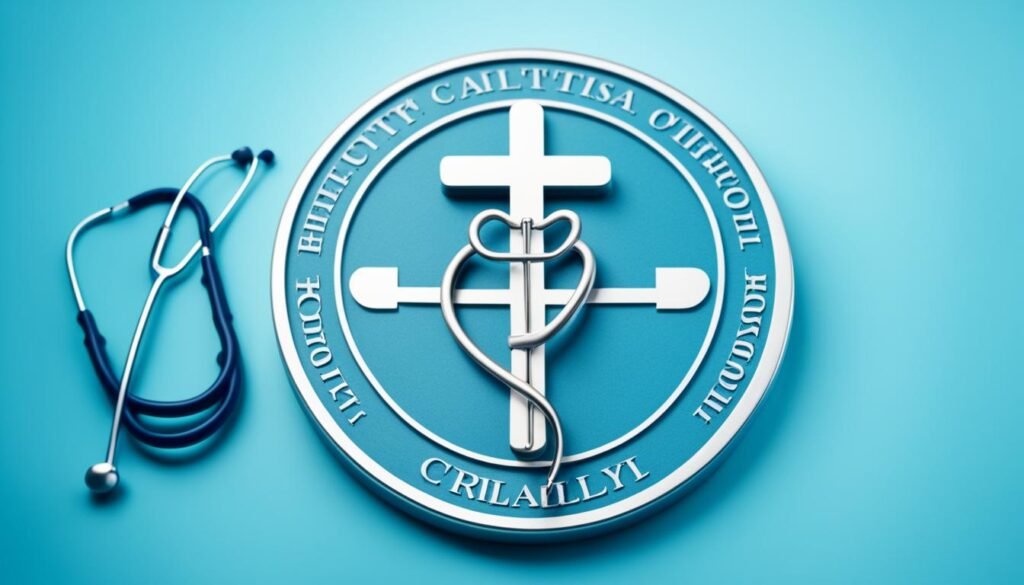Medical assistant training is the key to unlocking a successful healthcare career. Whether you aspire to work in clinical or administrative roles, this training equips you with the essential skills needed to thrive in a variety of healthcare settings, including clinics, hospitals, and doctors’ offices.
With a strong emphasis on interpersonal skills and a genuine desire to help people, medical assistants are poised to make a significant impact in this in-demand field. From providing compassionate patient care to tackling administrative tasks with efficiency and precision, medical assistants play a vital role in the healthcare system.
Key Takeaways:
- Medical assistant training offers opportunities for both clinical and administrative roles in the healthcare field.
- Strong interpersonal skills and a passion for helping patients are crucial for success in this career.
- Medical assistant training programs vary in length and requirements, with options such as diplomas, certificates, and associate degrees available.
- Choosing an accredited program ensures a quality education that meets industry standards.
- Admission requirements may include a high school diploma or GED, standardized test scores, and prerequisites.
The Importance of Researching the Medical Assistant Career
Before embarking on a career as a medical assistant, it is essential to conduct thorough research and gain a comprehensive understanding of the role. Medical assistants play a vital role in healthcare settings, performing a wide range of administrative and clinical tasks to ensure the smooth operation of medical facilities.
Administrative and Clinical Tasks:
Medical assistants have diverse responsibilities that encompass both administrative and clinical functions. On the administrative side, they schedule appointments, maintain patient records, handle billing and insurance claims, and coordinate communication between patients and healthcare providers. Meanwhile, on the clinical side, they assist with patient examinations, take vital signs, administer medications, collect laboratory specimens, and provide patient education.
Patient Care:
One of the most fulfilling aspects of a medical assistant career is the opportunity to directly contribute to patient care. Medical assistants work closely with other healthcare professionals in a team-oriented environment to provide high-quality care. They serve as a bridge between patients and healthcare providers, ensuring that patients feel supported and informed throughout their healthcare journey.
Strong interpersonal skills are essential for building rapport with patients, helping them feel comfortable and safe during medical procedures. Medical assistants must possess compassion, empathy, and excellent communication skills to effectively address patient needs and concerns.
“As a medical assistant, you have the privilege of making a positive impact on patients’ lives each day. Whether you’re providing emotional support, explaining treatment plans, or assisting during medical procedures, your dedication to patient care is invaluable.” – Dr. Sarah Johnson, Chief Medical Officer
Researching the Medical Assistant Career:
Prior to pursuing a medical assistant career, it is essential to conduct thorough research to ensure it aligns with your interests, skills, and long-term goals. Research can involve exploring job descriptions, educational requirements, career paths, and opportunities for advancement in this field. It is also beneficial to reach out to medical professionals, current medical assistants, and industry organizations to gather insights and firsthand information.
By conducting comprehensive research, you can make an informed decision about pursuing a medical assistant career and confidently embark on your educational journey.
Understanding Education Requirements for Medical Assistant Training

When considering a career as a medical assistant, it is important to understand the education requirements associated with this role. Medical assistant training programs offer various options for individuals looking to pursue this rewarding healthcare profession. Whether you choose a diploma, certificate, or associate degree program, each option provides a solid foundation of knowledge and skills necessary to excel in a clinical or administrative setting.
Types of Medical Assistant Training Programs
Medical assistant training programs typically offer three main options: diploma, certificate, and associate degree programs. Depending on your career goals and time availability, you can choose the program that best suits your needs. Here is a breakdown of the different options:
- Diploma Program: Diploma programs are generally shorter in duration, typically lasting between 9-12 months. These programs focus specifically on the essential knowledge and skills required for medical assisting. They provide a comprehensive education that prepares students for entry-level positions in healthcare settings.
- Certificate Program: Certificate programs are similar to diploma programs in terms of length and curriculum. However, certificate programs often have a broader scope and may offer additional coursework in specialized areas of medical assisting. This can provide graduates with a competitive edge in the job market.
- Associate Degree Program: An associate degree in medical assisting typically takes about two years to complete. This program provides a more comprehensive education, covering a broader range of subjects including general education courses. An associate degree can open up additional opportunities for career advancement and higher-level roles within healthcare organizations.
It is important to note that the specific requirements and duration of training programs may vary depending on the institution. Researching and choosing an accredited program is crucial to ensure the quality of education received.
Flexibility of Medical Assistant Training Programs
Medical assistant training programs recognize that individuals may have different scheduling needs and responsibilities to balance. Many programs offer flexible scheduling options to accommodate working adults and those with family obligations. This flexibility allows students to pursue their education while still meeting their personal and professional commitments.
The ability to choose between full-time and part-time study options, evening or weekend classes, and online or hybrid learning formats provides students with the flexibility they need to successfully complete their training program.
Benefits of Medical Assistant Training Programs
“Medical assistant training programs provide individuals with the comprehensive education and hands-on experience needed to excel in this in-demand healthcare profession. Whether you choose a diploma, certificate, or associate degree program, each option prepares you for a rewarding career in clinical or administrative roles. By choosing an accredited program and taking advantage of flexible scheduling options, you can embark on a successful journey towards becoming a skilled medical assistant.”
Completing a medical assistant training program not only ensures that you possess the necessary knowledge and skills to excel in a medical assistant role but also enhances your credibility and employability within the healthcare industry. It demonstrates your commitment to professional development and provides a solid foundation for further career advancement in the field.
Now that you understand the different education requirements for medical assistant training, you can make an informed decision about which program is best suited for you. Take the time to research accredited programs and consider your personal preferences, career goals, and time availability. Investing in your education and training will pave the way for a successful future in the dynamic and fulfilling field of medical assisting.
| Educational Program | Duration | Curriculum | Opportunities |
|---|---|---|---|
| Diploma | 9-12 months | Focus on essential medical assisting knowledge and skills | Entry-level positions in healthcare settings |
| Certificate | 9-12 months | Broader curriculum with specialization options | Competitive edge in the job market |
| Associate Degree | 2 years | Comprehensive education including general courses | Career advancement and higher-level roles |
Choosing an Accredited Medical Assistant Program

When embarking on your journey to become a medical assistant, it is crucial to choose an accredited program that provides a quality education. Accreditation ensures that the program meets specific standards and equips you with the necessary skills and knowledge to excel in your career. Look for programs that are accredited by reputable organizations such as the Commission on Accreditation of Allied Health Education Programs (CAAHEP) or the Accrediting Bureau of Health Education Schools (ABHES).
An accredited program offers several advantages:
- Quality education: Accreditation ensures that the program adheres to rigorous educational standards, providing you with the knowledge and skills necessary for success in your future career as a medical assistant.
- Industry recognition: Graduating from an accredited program enhances your professional reputation and increases your job prospects. Employers prefer hiring graduates from accredited programs as they are assured of their competence and expertise.
- Access to financial aid: Accredited programs often qualify for various financial aid options, including scholarships, grants, and student loans. This enables you to pursue your medical assistant training without worrying about the financial burden.
By selecting an accredited program, you are investing in your future as a medical assistant. The rigorous standards set by accrediting bodies ensure that you receive a comprehensive education that prepares you for the challenges and responsibilities of the healthcare industry.
Meeting Admission Requirements for Medical Assistant Training

Whether you’re a high school graduate or an adult looking to change careers, meeting the admission requirements for medical assistant training programs is a crucial step towards pursuing a fulfilling career in the healthcare field.
One of the fundamental admission requirements for most medical assistant training programs is a high school diploma or equivalency certificate such as a GED. This ensures that applicants have a solid educational foundation to build upon during their training. Individuals who have not completed high school education can pursue a GED to meet this requirement.
Standardized test scores may also be required as part of the admission process. These scores help programs assess an applicant’s academic abilities and readiness for the coursework. It is important to check with individual programs to determine which standardized tests are accepted and the minimum score requirements.
In addition, some medical assistant training programs may have specific prerequisites that need to be completed prior to admission. These prerequisites often include fundamental classes such as basic math, English composition, and biology. These foundational courses ensure that students have the necessary knowledge and skills to succeed in the program.
Each medical assistant training program may have its own specific checklist of admission requirements. It is essential to review the requirements carefully and to fulfill them before applying to ensure a smooth application process.
To provide a better understanding of the admission requirements, here is an example of a medical assistant training program’s checklist:
| Admission Requirements | Description |
|---|---|
| High School Diploma or GED | A certified copy of a high school diploma or equivalent must be submitted. |
| Standardized Test Scores | Applicants must provide official scores from an accepted standardized test (e.g., SAT, ACT). |
| Prerequisites | Successful completion of prerequisite courses including basic math, English composition, and biology. |
With a high school diploma or GED, satisfactory standardized test scores, and fulfillment of any prerequisites, you are well on your way to meeting the admission requirements for medical assistant training programs. Taking the time to ensure you meet these requirements will help you gain acceptance into the program of your choice and set you on the path towards a rewarding career as a medical assistant.
Exploring Financial Aid Options for Medical Assistant Training

When pursuing a career in medical assisting, the cost of training can be a concern for many individuals. Fortunately, there are various financial aid options available to help cover the expenses associated with medical assistant training.
One option to explore is scholarships, which are monetary awards granted to students based on their academic achievements, skills, or other criteria. Scholarships can provide significant financial assistance and do not need to be repaid. Many organizations, including medical assistant training schools, offer scholarships specifically for students pursuing a career in healthcare.
Another option is grants, which are similar to scholarships but are often based on financial need. Grants, like scholarships, do not require repayment, making them an attractive option for students seeking financial assistance. Grant opportunities can be found through federal and state governments, as well as private organizations.
Student loans are also commonly used to finance medical assistant training. These loans are borrowed money that must be repaid, typically with interest, after completing the training. It is important to research loan options and consider factors such as interest rates, repayment terms, and eligibility requirements when seeking student loans.
The Free Application for Federal Student Aid (FAFSA) is a vital tool in determining eligibility for federal financial aid programs. By completing the FAFSA, students can access various forms of financial aid for education, including grants and loans. It is recommended to complete the FAFSA as early as possible to maximize the potential financial aid opportunities.
Many medical assistant training schools also offer assistance in finding the right financing options for students. They may have financial aid advisors who can provide guidance and support in navigating the application process for scholarships, grants, and loans. These advisors can help students understand the requirements and deadlines for each financial aid option and assist in completing the necessary paperwork.
Attending Classes and Completing Coursework in Medical Assistant Training
Medical assistant training programs are designed to provide students with a comprehensive understanding of the field. Through a combination of theoretical knowledge and practical application, students gain the necessary skills to succeed in the clinical and administrative aspects of their future careers. Attending classes and completing coursework allows students to delve into various subjects that form the foundation of their medical assistant education.
Key Subjects in Medical Assistant Training
Medical Terminology: Understanding medical terminology is essential for effective communication within the healthcare industry. Students learn the meaning and usage of medical terms, equipping them with the language necessary to navigate medical charts, reports, and conversations with healthcare professionals.
Anatomy and Physiology: Medical assistants need a solid understanding of the human body’s structure and function. Courses in anatomy and physiology explore the body’s systems, including the cardiovascular, respiratory, digestive, and musculoskeletal systems. This knowledge is crucial for accurately assessing and documenting patients’ health status.
Clinical and Administrative Procedures: In order to fulfill their diverse responsibilities, medical assistants are trained in both clinical and administrative procedures. Clinical procedures cover tasks such as taking vitals, administering injections, and assisting with examinations, while administrative procedures encompass scheduling appointments, managing medical records, and billing patients and insurance providers.
Practical Skills: Medical assistant training doesn’t just focus on theory; it also emphasizes the development of practical skills. Students have the opportunity to practice various techniques, including taking blood pressure, performing EKGs, preparing and sterilizing instruments, handling medical emergencies, and applying first aid.
Flexible Learning Options
Medical assistant training programs understand the importance of flexibility for students who may have other commitments or responsibilities. To accommodate diverse schedules, many programs offer classes during evenings and weekends. This allows individuals to pursue their education while maintaining their existing work or personal life. Whether attending full-time or part-time, students have options that fit their unique circumstances.
| Subject | Description |
|---|---|
| Medical Terminology | Learn the language of the healthcare industry and effectively communicate within medical settings. |
| Anatomy and Physiology | Understand the structure and function of the human body to assess patients accurately and document their health status. |
| Clinical and Administrative Procedures | Acquire the practical skills needed to perform various clinical and administrative tasks in a healthcare setting. |
| Practical Skills | Develop hands-on skills such as taking vitals, performing EKGs, and handling medical emergencies. |
Completing coursework and attending classes in a medical assistant training program provides students with a solid foundation in medical terminology, anatomy and physiology, clinical and administrative procedures, and practical skills. This well-rounded education equips aspiring medical assistants with the knowledge and abilities necessary to excel in their future careers.
img src=”https://seowriting.ai/32_6.png” alt=”clinical and administrative procedures” />
Gaining Clinical Experience in Medical Assistant Training

Clinical experience is an integral part of medical assistant training, providing students with hands-on experience in a healthcare setting. Many programs include a clinical experience or externship component, allowing students to apply their knowledge and skills in a real-world environment. This valuable opportunity allows students to work alongside experienced professionals in various healthcare settings, such as clinics, hospitals, and doctors’ offices.
During their clinical experience, students have the chance to observe and participate in a range of tasks and procedures. They may assist with patient intake, take vital signs, perform basic laboratory tests, and even assist healthcare professionals during examinations and treatments. This hands-on experience helps students develop the practical skills necessary for a successful career as a medical assistant.
Working in a healthcare setting during their training also allows students to gain a deeper understanding of the dynamic healthcare industry. They become familiar with the daily routines and operations of different healthcare facilities, as well as the challenges and rewards of working directly with patients.
The Benefits of Clinical Experience
The clinical experience component of medical assistant training offers several benefits to students:
- Enhanced Skills: Clinical experience provides an opportunity to apply theoretical knowledge and develop practical skills in a real-world setting. This hands-on experience strengthens students’ abilities and prepares them for the responsibilities they will undertake as medical assistants.
- Professional Networking: Working alongside experienced healthcare professionals during clinical experience allows students to build valuable connections within the industry. These connections can lead to future job opportunities and mentorship.
- Confidence and Competence: Clinical experience builds confidence and competence in students, empowering them to enter the workforce with the necessary skills and knowledge to excel in their roles.
Participating in a clinical experience or externship is often a requirement for completing medical assistant training programs. It provides a unique opportunity for students to bridge the gap between classroom learning and real-world practice.
Obtaining Certification for Medical Assistants
While not always required, obtaining certification as a Certified Medical Assistant (CMA) can significantly enhance job prospects and earning potential in the healthcare industry. Employers often prefer to hire certified medical assistants as it demonstrates their commitment to professionalism and competence in their field.
To become a certified medical assistant, individuals need to pass a certification exam administered by certifying organizations such as the American Association of Medical Assistants (AAMA). This exam assesses their knowledge and skills in essential areas of medical assisting, including clinical procedures, office administration, medical terminology, and patient care.
Medical assistant training programs often provide preparation for the certification exam, equipping students with the necessary knowledge and skills to succeed. These programs cover a wide range of topics, ensuring that aspiring medical assistants are well-prepared to meet the requirements of the exam and their future career.
Achieving certification as a medical assistant can open doors to a variety of job prospects. Certified medical assistants are sought after by healthcare facilities, including hospitals, clinics, and specialty practices. This certification validates their competence and professionalism, making them stand out among other applicants.
Beyond job prospects, earning potential is also positively impacted by certification. Certified medical assistants often earn higher salaries and enjoy greater job security. Employers recognize the value of their expertise and are willing to offer competitive compensation packages to attract and retain these highly skilled professionals.
With the combination of medical assistant training, practical experience, and certification, individuals can position themselves as competent and qualified medical assistants in a field that offers stability, growth, and rewarding opportunities.
Networking and Job Search Strategies for Medical Assistants

Networking plays a crucial role in launching a successful career as a medical assistant. By leveraging the connections made during training, you can tap into the vast network within the healthcare industry to explore job opportunities that align with your ambitions. Medical assistants have the flexibility to work in various healthcare settings, including physician’s offices, hospitals, and specialty clinics. To maximize your networking efforts and enhance your job placement prospects, consider the following strategies:
1. Attend Industry Events and Conferences
Industry events and conferences provide excellent opportunities to expand your professional network. By attending seminars and workshops, you can connect with healthcare professionals who may have job openings or know of potential job opportunities. Engage in conversations, exchange contact information, and follow up with those you meet to nurture valuable connections.
2. Utilize Online Networking Platforms
In today’s digital age, online networking platforms have become indispensable tools for job seekers. Utilize professional networking platforms such as LinkedIn to showcase your skills and experiences. Connect with professionals in the medical field, join relevant groups, and actively engage by sharing insightful content and participating in discussions. Online platforms also enable you to discover job openings and connect with recruiters directly.
3. Engage with Alumni Networks and Associations
Reach out to alumni from your medical assistant training program and engage with professional associations related to medical assisting. Alumni networks and associations often offer valuable resources, mentorship opportunities, and job boards that can assist you in finding job placement. Stay actively involved, attend events, and take advantage of the expertise and connections within these networks.
4. Seek Internship or Externship Opportunities
Internship or externship programs provide invaluable hands-on experience and allow you to establish connections within healthcare organizations. During these placements, make a concerted effort to network with professionals in your desired healthcare setting. Demonstrate your skills, professionalism, and dedication, as these experiences can often lead to job offers or serve as strong references for future job applications.
5. Leverage Personal Connections
Reach out to friends, family, and other personal connections who may have connections or insights within the healthcare industry. They may be aware of job opportunities or be able to introduce you to influential individuals who can help advance your career. Don’t underestimate the power of personal connections in uncovering hidden job opportunities.
By combining these networking strategies with a proactive job search approach, you can increase your job placement opportunities within the medical assistant field. Remember to tailor your efforts to specific healthcare settings, such as physician’s offices, hospitals, or specialty clinics, to align with your career goals.
Becoming a certified medical assistant can open doors to a rewarding career in the healthcare industry. Whether you choose to work in medical facilities, hospitals, or clinics, a medical assistant certificate from an accredited program, such as those offered by the American Medical Technologists or the National Healthcareer Association, establishes your qualifications. These programs, whether offered online or in a clinical setting, prepare you for the diverse tasks of a medical assistant, including administrative and clinical responsibilities. From coding and medical records auditing to assisting with medical histories and emergencies, a certified medical assistant is equipped with the skills and knowledge needed to excel in various healthcare roles. With a positive job outlook projected overall by 2028, according to the Department of Labor, and competitive salaries, pursuing certification as a medical assistant offers promising opportunities for those with experience in the healthcare industry or those seeking to enter this rewarding field.
Becoming a certified medical assistant opens the door to a fulfilling career in the healthcare industry. Whether you’re seeking medical assistant jobs in hospitals, clinics, or other medical facilities, holding a medical assistant certificate from an accredited program, such as those developed and taught by the National Healthcareer Association, establishes your qualifications. These programs, whether completed online or through clinical training, prepare you for the diverse tasks and responsibilities of a medical assistant, encompassing both administrative and clinical duties. From assisting with medical histories and emergencies to coding and medical records auditing, a certified medical assistant plays a crucial role in providing quality patient care. With a positive job outlook projected overall by 2028, according to the Department of Labor, and competitive salaries, pursuing certification as a medical assistant offers promising opportunities for healthcare professionals seeking career advancement or entry into the field.
Medical assistants play a vital role in the healthcare field, providing essential administrative and clinical support in medical offices, clinics, and other healthcare facilities. Pursuing a medical assistant program not only provides comprehensive training in medical terminology, medical billing, and medical records management but also prepares you for certification as a certified clinical medical assistant (CCMA) through organizations like the National Healthcareer Association (NHA). With a high school diploma as a prerequisite, medical assistant training programs encompass a range of clinical procedures, including administering vital signs, assisting with examinations, and even surgical procedures in outpatient settings. Upon completion of the program and passing the certification exam, registered medical assistants are equipped to perform a variety of tasks, from scheduling appointments to handling insurance claims, in both administrative and clinical capacities. With job training tailored to the demands of the healthcare environment, medical assistants are ready to make a meaningful impact in patient care and contribute to the efficient operation of medical practices.
Also Read: Top 10 Cancer Hospitals in Chennai for World-Class Treatment
Conclusion
A career in medical assisting is both fulfilling and rewarding, offering a secure and in-demand healthcare path. Medical assistants play a crucial role in providing top-quality care to patients, combining clinical and administrative skills to support medical professionals in various healthcare settings. With the right education and training, individuals can embark on a fulfilling medical assistant career.
Professional associations are invaluable resources for medical assistants, providing networking opportunities and access to industry insights. Joining a professional association allows medical assistants to connect with peers, stay updated on the latest trends and best practices, and enhance their professional growth. These associations provide a supportive community for medical assistants to exchange knowledge and collaborate on improving patient care.
Continuing education is essential for medical assistants to stay current with advances in healthcare and expand their skill set. Engaging in professional development activities, such as workshops, conferences, and online courses, enables medical assistants to enhance their knowledge and adapt to evolving industry standards. By continually updating their skills and staying informed, medical assistants can provide the highest level of care to patients and remain competitive in their field.
FAQs
Q: What is the job outlook for certified clinical medical assistants?
A: The job outlook for certified clinical medical assistants is very promising, with a growing demand for healthcare professionals in various medical settings.
Q: How can I become a medical assistant?
A: To become a medical assistant, you typically need to complete a medical assisting program, obtain certification, and gain practical experience through internships or job training.
Q: What are the prerequisites and requirements for enrolling in a medical assistant training program?
A: Prerequisites for enrolling in a medical assistant training program usually include a high school diploma or GED, along with a desire to work in the healthcare field.
Q: What is the tuition for medical assistant training programs?
A: The tuition for medical assistant training programs can vary depending on the institution, location, and program duration. It is important to research and compare different options before enrolling.
Q: What is the job outlook for certified medical administrative assistants?
A: Certified medical administrative assistants also have a positive job outlook, as they play a crucial role in managing medical offices and ensuring efficient operations.
Q: What are the responsibilities of clinical medical assistants?
A: Clinical medical assistants perform a variety of tasks, including taking patient vital signs, assisting with medical procedures, updating medical records, and ensuring patient comfort in clinical settings.
Q: Can I complete medical assistant training online?
A: Yes, there are online medical assistant training programs available that can prepare you to work as a certified medical assistant in both administrative and clinical roles.
Q: What is the salary range for a medical assistant?
A: The salary for a medical assistant can vary based on factors such as experience, location, and employer. According to the Bureau of Labor Statistics, the median annual wage for medical assistants is around $35,850.
Source Links
- https://info.athenacareers.edu/blog/your-guide-to-starting-a-medical-assistant-career
- https://learn.yourdreamdegree.com/blog/steps-to-take-to-start-your-career-as-a-medical-assistant-education-training-certifications-and-more
- https://wsmda.edu/how-to-prepare-for-a-medical-assistant-program-the-ultimate-guide/
